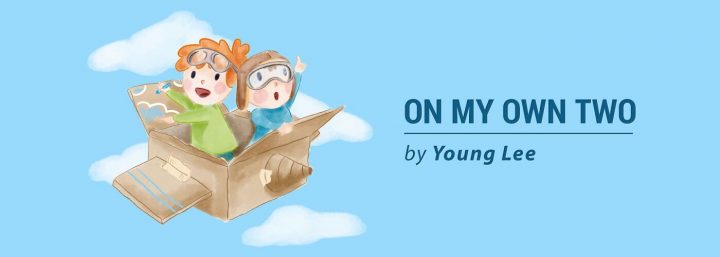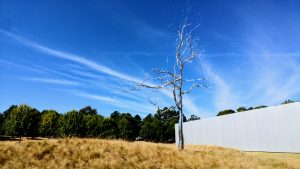Thoughts on CMT and ‘Askew’
Written by |

Column by Young Lee
“Askew,” a work of art by American painter and sculptor Roxy Paine, stands just outside the West Building at the North Carolina Museum of Art. It’s an almost 50-foot, tree-like metal structure, with a trunk and branches that stretch away from the museum and toward the sky.
Although the temptation is to refer to it as a faux “tree,” Paine eschews that term in favor of calling this type of sculpture a “dendroid.” The term allows viewers to take in and understand the sculpture as any kind of branching concept.
I think the term may be appropriate. After all, if trees can think, the ones that stand in proximity to “Askew” must not regard the odd metal structure with leafless branches as one of them.
I’ve lived much of my life close to the Raleigh museum, and I’ve always enjoyed my trips there. During college, it was a good place to read and study. While I was between jobs, it was a nice place to go for a walk and collect my thoughts. As an introvert, it was a refuge — a place where it’s socially acceptable to be quiet and alone with my thoughts.
I think art reveals as much about the observer as it does the artist. So I discover new things even when viewing the permanent collection for the umpteenth time, because I’ve grown with time.
As I passed “Askew” during a recent trip to the museum, I reflected on how I’ve changed during the months since my last visit. Perhaps it’s not a surprise that “Askew” reminded me of what I’ve learned and the opinions I’ve developed as a guy with Charcot-Marie-Tooth (CMT).
Earlier this year, I went from being fairly oblivious to the CMT community to taking baby steps to reach out and participate in CMT events. I wrote about how surprised I was to find that there were multiple kinds of CMT. And a few days ago, I found myself eagerly looking through genetic test results detailing my father’s specific CMT type, knowing my siblings and I likely have the same type.
Before this year, I didn’t feel the need to take a long-term approach to my CMT. I felt like my symptoms weren’t too bad, and I could think about coping with worse when worse came. For now, I walk without ankle-foot orthoses and can manage most of the muscle pain. And I can still open most jars and bottles without tools.
But my perspective has changed. At the last Charcot-Marie-Tooth Association Patient/Family conference, Dr. Raghav Govindarajan encouraged me to take a more proactive approach to manage my CMT. I’ve been trying to change a few habits to do just that, although I still have many bad and counterproductive days.
So when I looked up at “Askew” and its poor leafless branches, I was reminded to live fully and manage CMT holistically.
I’ve always loved “Askew” and the way it has represented — for me — a feeble challenge to the lifestyle represented by nature growing around it. In the past, it reminded me of the importance of real, human connection in an age of constant distractions from social media and technology.
Maybe that’s why “Askew” stands in a state of perpetual winter: Its metal exterior is guarding against the community growing around it. It has no real roots to take in water (a docent once told me she believes it has a concrete base), and this “dendroid” actually reflects sunbeams.
But “Askew” also reminds me to consider aspects important to a holistic approach to wellness: to branch out and participate in the community around me, to stay grounded and take in spiritual nourishment when necessary, and to take the time to enjoy and celebrate good times.
I’m not an art critic, just an admirer. But “Askew” is a special totem for me. I think I will continue to think about “Askew” as I grow and mature.
***
Note: Charcot-Marie-Tooth News is strictly a news and information website about the disease. It does not provide medical advice, diagnosis, or treatment. This content is not intended to be a substitute for professional medical advice, diagnosis, or treatment. Always seek the advice of your physician or other qualified health provider with any questions you may have regarding a medical condition. Never disregard professional medical advice or delay in seeking it because of something you have read on this website. The opinions expressed in this column are not those of Charcot-Marie-Tooth News or its parent company, Bionews Services, and are intended to spark discussion about issues pertaining to Charcot-Marie-Tooth.






Leave a comment
Fill in the required fields to post. Your email address will not be published.